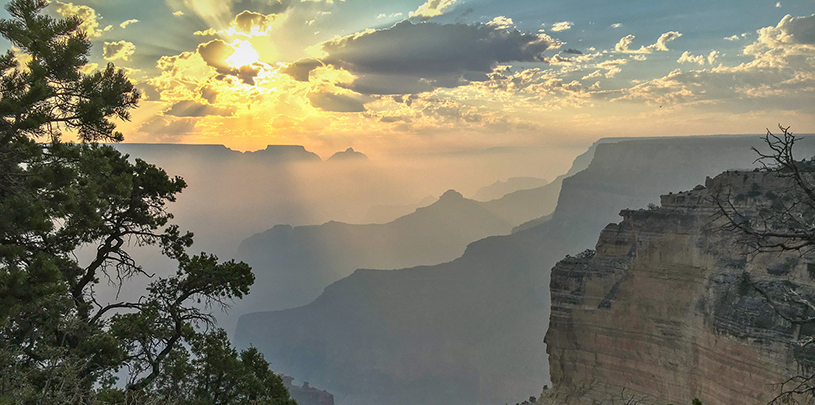
by Amber Reimondo, Energy Director
Not mining radioactive uranium or other minerals near the Grand Canyon seems like a no-brainer, yet over 800 active mining claims lie in wait on about 1 million acres of public lands surrounding the national park.
Since 2012, a temporary ban has prevented those claims from being turned into new mines. But as uranium companies and their allies in Congress continue to push for lifting the ban, and for taxpayer subsidies to artificially prop up the domestic uranium-mining industry, it's worth pointing out why mining uranium so near the Grand Canyon is such a bad idea. Here's a little refresher, in no particular order:
Two-hundred and seventy-seven miles long and a mile deep, carved by water and time, the Grand Canyon needs no introduction. If you want to talk titles, it's not just a national park, it's also a UNESCO World Heritage Site and one of the Seven Natural Wonders of the World. But since a picture is worth 1,000 words, let's just cut to the chase here. You want a reason uranium mining doesn't belong here? Here's one:

Grand Canyon National Park already bears the scars of uranium mining and suffers the long legacy of uranium contamination.
Orphan uranium mine, on the South Rim inside the park, just a short walk from the busy tourist village, is fenced off to protect visitors from radiation and contaminated soil. The water in Horn Creek, below the mine, is radioactive to the point that the National Park Service warns hikers not to drink from it unless death by thirst is the only alternative.
More than a national park, the Grand Canyon is the ancestral homeland of many Indigenous peoples. While the National Park Service officially recognizes 11 Native American tribes and nations with historic and cultural ties to what is now the park, many more have connections to the Grand Canyon.
East of the national park, over 500 uranium mines lie abandoned on the Navajo Nation, contaminating land and water and exposing Navajo Nation citizens to harmful radiation.
The Havasupai Tribe, whose people make their home at the bottom of a side canyon off the Grand Canyon, fear that Canyon uranium mine, south of the national park and currently exempt from the temporary mining ban, could contaminate the aquifer that feeds its famous blue-green waterfalls and is the sole source of the tribe's drinking water.
The tribe has fought Canyon Mine and other uranium mines around the Grand Canyon on the ground and in court for decades. The Hualapai Tribe and the Hopi Tribe, alongside the Navajo Nation, the Havasupai Tribe, and many others, support permanently protecting lands around the Grand Canyon from the perils of uranium mining.
To ignore these calls is to ignore and continue the generations of injustice faced by Indigenous peoples at the hands of the U.S. government.
And it’s a complicated question to answer. The ground around the Grand Canyon is fractured rock, which makes it extremely difficult to predict with any accuracy how water flows through it and how long it takes to get from point A to point B.
For example, in one study, scientists placed dye in sinkholes on the Grand Canyon's north rim to try to determine where water from various locations emerges into the seeps and springs inside the canyon. They found that the dye did not show up in all the places they expected it would, and that it was carried in many directions through almost 6,500 vertical feet of rock and traveled up to 25 miles horizontally in a matter of weeks. In one instance, dye samples placed in the same fault emerged in two totally different locations.
If water becomes contaminated with uranium, as it has at Canyon Mine and other mines in the region, once it seeps in between rocks, no one knows exactly where in the Grand Canyon region it will end up, or how long it will take to get there. If contamination does occur, it may very well be impossible to clean up.
Pre-COVID-19, nearly 6 million people visited Grand Canyon National Park annually. People come from across the United States and the world to stare in awe at the canyon's breathtaking displays of color and light.
In 2018, park visitors spent $947 million in communities near the park and that spending supported 12,558 jobs and had a cumulative benefit to the local economy of $1.2 billion. Tourism, not mining, is what keeps northern Arizona in business, which explains the broad support from the business community for a permanent uranium ban here.
Polling shows that two out of three registered Arizona voters support the current ban on uranium mining around the Grand Canyon. Majorities of voters across the political spectrum support continuing the ban on new mining — this is true for Republicans, Democrats, and independents. Almost three-quarters of voters believe outdoor recreation is more important to the future of the Arizona economy than mining, period.
The list goes on. The Grand Canyon region and its peoples have already witnessed firsthand the damage and the suffering uranium mining can cause.
The Grand Canyon region is too precious to mine. It's time to ban new uranium mines around the canyon forever.
Act now. Urge your senators to support, co-sponsor, and push for a committee hearing for S. 387, the Grand Canyon Protection Act, to permanently ban new uranium mines on public lands around the Grand Canyon.
80% of Arizona voters support Baaj Nwaavjo I'tah Kukveni National Monument, according to a new poll.
Read MoreThe Colorado River below Glen Canyon Dam is heating up. Find out why.
Read MoreGroundwater pumping at a uranium mine near the Grand Canyon will affect the canyon's springs, scientists says.
Read More